
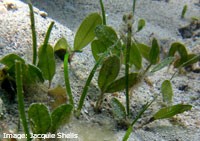





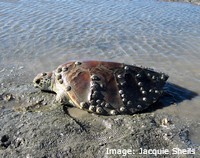







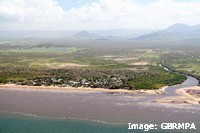
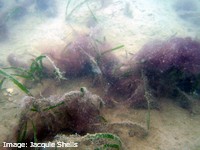
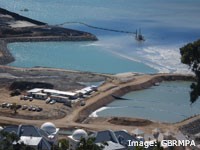



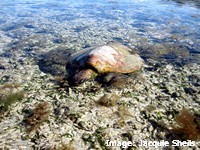

Green turtles
Green turtles (Chelonia mydas), are air breathing reptiles, one of the world’s seven species of sea turtle. They are the only species of sea turtle which is mostly vegetarian. Unfortunately for them, this diet has made them the species of sea turtle most hunted by people for food.
Why green?
The common name 'green' turtle comes from the green colour of their fat and muscles, caused by their plant-based diet. Sea turtles evolved about 150 million years ago, in the age of the Dinosaurs, and their body design has been so successful that they have changed little since then.
Remarkable armour
Green turtles have broad, flattened ribs that are joined to each other and are fused to the spine, and a broad bony plate under their bodies, producing a bony case that completely encloses everything except the turtle’s limbs and head. The internationally respected biologist Dr Alfred Sherwood Romer wrote in 1933:
'Because they are still living, turtles are commonplace objects to us; were they extinct, their shells - the most remarkable armour ever assumed by a tetrapod (4 legged) animal – would be a cause for wonder.'
This protective case has served them well, as adult sea turtles have relatively few predators, apart from sharks, crocodiles and humans.
Traditional hunting
The meat and eggs of Green turtles have been a traditional food for Aboriginal and Torres Strait Islander people for thousands of years.
Turtles on the menu
In the 19th century Green turtles were the main ingredient in a popular European delicacy, turtle soup. The abundance of green turtles on the Great Barrier Reef encouraged the Queensland Director of Fisheries, William Saville-Kent, to promote canned turtle meat and turtle shell industries in Queensland. In 1904 a cannery was established on Heron Island, harvesting female Green turtles as they came ashore to lay their eggs.
The large numbers of female turtles coming ashore to nest, and the large clutches of eggs they laid, led people to believe that they were an inexhaustible resource. By the 1930s the cannery on Green Island closed for want of Green turtles to harvest and people began to realise that they reproduced at a very slow rate. Even so, turtles were still being commercially harvested in Queensland until the 1950s. All harvesting of turtles and their eggs has been banned in Queensland since 1968, apart from Aboriginal and Torres Strait Islander traditional hunting.
Turtles and tourism
The turtle cannery on Heron Island also hosted visiting tourists, who enjoyed ‘turtle riding’ both as the turtles came up the beach to lay their eggs, and in the water. Turtle riding was promoted as a popular part of Great Barrier Reef tourism until about the 1950s.
Later on, as more was learned about the lives of sea turtles and they became more scarce, these harmful and stressful interactions went out of fashion and people looked for less intrusive and stressful ways of interacting with turtles. Turtles are now protected on the Great Barrier Reef and visitors watch turtles behaving naturally in the wild, through programs like the Turtle Research program at Mon Repos, near Bundabreg, or the Turtle Hospital at Reef HQ Aquarium in Townsville.
Turtle biology
Green turtles can grow to about 1m shell length and may weigh up to 150kg. Females grow larger than males and adult males have longer tails. They are very slow growing and may live for 80 years or more. As air-breathing reptiles they must surface regularly to breathe; the length of time that they can stay submerged depends on their levels of stress and activity. While they are actively feeding they will stay underwater for around 4-5 minutes between surfacing for breaths, but they can also sleep underwater for up to several hours without surfacing.
Sea turtles don’t need to drink fresh water because they can get rid of the excess salt from seawater through special ducts next to their eyes. When females are ashore laying eggs the salty secretion looks like tears. During their long migrations,sea turtles sense the strength and angle of the earth’s magnetic field, which varies depending on your position on the earth, allowing them to navigate across the sea.
Almost vegetarian...
Adult Green turtles mainly eat seagrass, but they will also eat algae, mangrove seeds, sponges and jellyfish. Green turtle hatchlings are omnivorous and will eat whatever they can find at the water's surface.
Global citizens
The lifestyle of a green turtle makes them truly global citizens: as they move through their life cycle they are dependant on completely different habitats, hundreds of kilometres apart and often in different countries. They live in the waters of more than 140 countries and they nest in about 80 countries.
Their habitats are in tropical and subtropical waters of the Atlantic, Pacific and Indian oceans and in the Caribbean and Mediterranean Seas. The two biggest nesting areas for Green turtles are Tortugueros in Costa Rica and Raine Island on the Great Barrier Reef.
Green Turtles on the Great Barrier Reef
The Great Barrier Reef is an important stronghold for Green turtles, they are abundant in inshore seagrass habitats and every reef hosts a small resident population. The most important nesting areas are the offshore islands and cays north of Princess Charlotte Bay in the northern Great Barrier Reef (GBR), down to the Swains reefs and Carpricorn Bunker Group of Islands in the southern GBR. There is scattered nesting in the Whitsunday region on mainland and island beaches.
Home bodies & great travellers
Green turtles that hatch on the Great Barrier Reef disappear into the Pacific Ocean gyre, completing a full circuit before returning when they are about 5-10 years old. After these so-called 'lost years' when they are rarely seen, they return to a shallow reef or coastal seagrass bed and set up home. Once Green turtles settle on a good spot to feed they can remain there for many years, even using exactly the same spot to sleep every night.
Life begins at 40?
Once they reach breeding age at between 25-50 years old, Green turtles get itchy feet again, migrating up to 2600km to breed, every 1-9 years. The frequency of Green turtle breeding varies because their breeding cycles are tuned in to the sea surface temperature in their feeding grounds. Males and females return to breed at beaches in the region where they hatched, where the females go ashore to lay their eggs.
Tagging research has found that green turtles living side by side can migrate to breed and nest in different locations. Green turtles that nest in the Great Barrier Reef region migrate from Indonesia, Torres Strait, Papua New Guinea, the Solomon Islands, Vanuatu, New Caledonia, Arnhem Land and the Gulf of Carpentaria. Some of the Green turtles that feed in the Great Barrier Reef region nest along the West Australian coast.
Making more turtles
Green turtles gather to mate off their nesting beaches between September and November in the Central Great Barrier Reef. Mating turtles are a common sight in sheltered bays around the Whitsunday Islands and mainland coast at this time of year.
Males hang around in the waters off the nesting beaches, waiting for a chance to mate with the females, who will store sperm from multiple males to fertilise each batch of eggs. After mating the male's work is done and they depart for their feeding areas.
The female's work has only just begun: they then come ashore on island and mainland beaches between November and March, returning every 2 weeks until they have laid up to 5 clutches of around 115 eggs.
Not all beaches are created equal
Not every beach is right for nesting: for hatchlings to develop, the sand of the nesting beach must be well aerated, protected from flooding by tides or creeks, free of disturbance from storms and egg predators, not too salty, moist but not too wet, and between 25-33˚ C.
The sex of hatchlings depends on the temperature of the sand that the eggs are buried in: boys are cool (all boys at or below 26˚ C) and girls are hot (all girls at or above 29˚ C). Nests with a range of temperatures in between produce a mixture of both sexes.
'Survivor', turtle style
Hatchlings take around 64 days to develop and usually emerge en-mass, at dusk or at night, using their numbers and the cover of darkness to increase their chances of avoiding predators. Even so, large numbers fall prey to birds and crabs, and many more to fish, during their race for the open sea. As they emerge and cross the beach, they somehow imprint chemical and positional information about where they are, so that can return as adults to breed.
Hatchlings are strongly attracted to light that is low on the horizon, which would normally be light reflected from the sea and would attract them seawards. This instinct can get them into trouble when we put artificial lighting along shorelines, attracting them inland to a sticky end on roads or on the menu of suburban pets. Offshore lighting at resorts, port facilities and large-ship anchorages also attracts hatchlings and makes them vulnerable to bird predation.
Fuelled by the yolk sac which they swallow before hatching, hatchlings swim perpendicular to the waves for up to 2 weeks without feeding, towards the open sea, where there are less predators. The lucky ones, about one in one thousand, will then enter the deep ocean gyres, where they spend the next ten years or so floating at the surface in drift-lines of flotsam and drifting Sargassum sp. seaweed. During this stage of their lives they are omnivorous, eating whatever they come across floating on the surface.
Turtles in trouble
Green turtles face numerous threats to their survival, including:
- Disturbance during nesting from people, pets, vehicles and lights near nesting beaches
- Loss of feeding and breeding habitat due to coastal development
- Entanglement in, and ingestion of marine debris, especially plastics
- Discarded fishing gear ('Ghost nets') and shark control nets trap and drown turtles.
- Turtles are accidentally caught in some fisheries, although measures to minimise by-catch of turtles such as Turtle Excluder Devices in trawl nets, are mandatory on the Great Barrier Reef
- Introduced species such as feral pigs and dogs which dig up nests and eat turtle eggs
- Boats travelling fast through shallow seagrass areas which can hit and injure or kill turtles
- Climate change threatens turtles by changing the sea surface temperature, disrupting breeding cycles, and altering sand temperatures on nesting beaches, disrupting the sex ratios of hatchlings.
- Changes in sea level and storm frequency due to climate change threaten the seagrass habitats that turtles depend on for food
- Overseas, in addition to the threats above, unsustainable hunting and collecting of eggs remains a threat to sea turtles.
How you can help Green turtles...
- Go slow for those below!! Sea turtles feed in shallow inshore waters: slow your boat speed and keep a good lookout to avoid striking turtles. If you can, travel at speed in deeper water, where there is less turtle activity
- Report stranded or dead sea turtles: call the marine Animal Stranding Hotline at RSPCA Qld 1300 ANIMAL (1300 264625)
- Avoid disturbing turtles on beaches during the nesting season and avoid using lights that might frighten females laying eggs or cause hatchlings to head inland
- Keep your dog under control on the beach during turtle nesting season
- Don’t drive vehicles in the dunes where turtles nest
- Support local programs to restore and protect turtle nesting and feeding habitat
- Support local programs to control feral animal pests
- Avoid littering the marine environment: pick up litter when you visit the beach, even if it isn’t yours!
- Water quality begins at home (and at work...)! Remember that the chemicals you use will ultimately end up in the sea. Use environmentally friendly chemicals; avoid artificial herbicides and pesticides if you can. If you have to use harmful chemicals, follow the instructions on the label carefully and avoid uses that might let chemicals wash into drains or waterways.
- Buy turtle-friendly seafood products: Australian prawn fishermen use turtle excluder devices on their trawl nets
- Check your crab pots regularly: turtles die when they become entangled in poorly designed or abandoned crab pots
- When you travel, don’t buy souvenirs made from turtles
- Support programs that conserve turtles in developing countries
More information:
GBRMPA Responsible Reef Practices:
Get involved: report turtle sightings:
Volunteer groups:
Sea Turtle Foundation (Townsville)
Downloadable resources:
GBRMPA Tropical Topics: Seagrass
GBRMPA Tropical Topics: Stories from the Blue Highway
Environment Australia: Green Turtles Factsheet
Marine Animal Stranding Hotline poster
Australian Government brochure: Harmful Marine Debris
Looking after protected species in Queensland: a guide for recreational fishers
Looking after protected species in Queensland: a guide for commercial fishers
Websites:
Sea Turtle Foundation (Townsville)
Queensland Museum: Green turtles
Environment Australia: Green Turtle Chelonia mydas
DAFF Queensland: Turtle excluder devices
Looking after protected species in Queensland: a guide for commercial fishers
Reports:
A biological review of Australian Marine Turtles
Recovery Plan for Marine Turtles in Queensland
Exploiting Marine Wildlife in Queensland: The Commercial Dugong and Marine Turtle Fisheries


